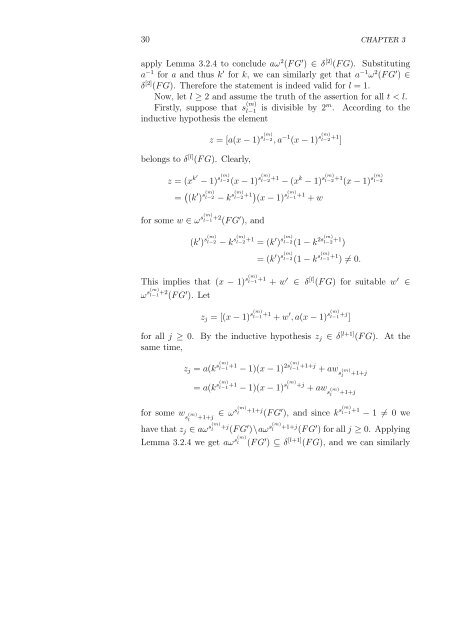On the Derived Length of Lie Solvable Group Algebras
On the Derived Length of Lie Solvable Group Algebras
On the Derived Length of Lie Solvable Group Algebras
You also want an ePaper? Increase the reach of your titles
YUMPU automatically turns print PDFs into web optimized ePapers that Google loves.
30 CHAPTER 3<br />
apply Lemma 3.2.4 to conclude aω2 (F G ′ ) ∈ δ [2] (F G). Substituting<br />
a−1 for a and thus k ′ for k, we can similarly get that a−1ω2 (F G ′ ) ∈<br />
δ [2] (F G). Therefore <strong>the</strong> statement is indeed valid for l = 1.<br />
Now, let l ≥ 2 and assume <strong>the</strong> truth <strong>of</strong> <strong>the</strong> assertion for all t < l.<br />
Firstly, suppose that s (m)<br />
l−1 is divisible by 2m . According to <strong>the</strong><br />
inductive hypo<strong>the</strong>sis <strong>the</strong> element<br />
belongs to δ [l] (F G). Clearly,<br />
z = (x k′<br />
z = [a(x − 1) s(m)<br />
l−2, a −1 (x − 1) s(m)<br />
l−2 +1 ]<br />
− 1) s(m)<br />
l−2(x − 1) s(m)<br />
l−2 +1 − (x k − 1) s(m)<br />
l−2 +1 (x − 1) s(m)<br />
l−2<br />
= (k ′ ) s(m)<br />
l−2 − k s(m)<br />
l−2 +1 (x − 1) s(m)<br />
l−1 +1 + w<br />
for some w ∈ ω s(m)<br />
l−1 +2 (F G ′ ), and<br />
(k ′ ) s(m)<br />
l−2 − k s(m)<br />
l−2 +1 = (k ′ ) s(m)<br />
l−2(1 − k 2s(m)<br />
l−2 +1 )<br />
= (k ′ ) s(m)<br />
l−2(1 − k s(m)<br />
l−1 +1 ) = 0.<br />
This implies that (x − 1) s(m)<br />
l−1 +1 + w ′ ∈ δ [l] (F G) for suitable w ′ ∈<br />
ω s(m)<br />
l−1 +2 (F G ′ ). Let<br />
zj = [(x − 1) s(m)<br />
l−1 +1 + w ′ , a(x − 1) s(m)<br />
l−1 +j ]<br />
for all j ≥ 0. By <strong>the</strong> inductive hypo<strong>the</strong>sis zj ∈ δ [l+1] (F G). At <strong>the</strong><br />
same time,<br />
for some w s (m)<br />
l<br />
have that zj ∈ aωs(m) l<br />
zj = a(k s(m)<br />
l−1 +1 − 1)(x − 1) 2s(m)<br />
= a(k s(m)<br />
l−1 +1 − 1)(x − 1) s(m)<br />
l<br />
∈ ωs(m) l<br />
+1+j<br />
l−1 +1+j + aw s (m)<br />
l<br />
+j + aw s (m)<br />
l<br />
+1+j<br />
+1+j<br />
+1+j (F G ′ ), and since k s(m)<br />
l−1 +1 − 1 = 0 we<br />
+j (F G ′ )\aωs(m) l +1+j (F G ′ ) for all j ≥ 0. Applying<br />
Lemma 3.2.4 we get aω s(m)<br />
l (F G ′ ) ⊆ δ [l+1] (F G), and we can similarly


